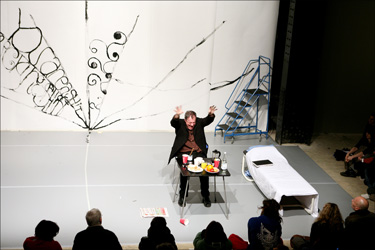Matt Mullican, Matt Mullican Under Hypnosis, 2007.
Born 1951 in Santa Monica, California; lives in New York, New York
Matt Mullican’s art takes form as drawing, sculpture, video, painting, electronic media, and installation, but his contribution to the 2008 Whitney Biennial might be best approached under the loose rubric of performance art. Since the late 1970s he has used hypnosis in his work, and the process both informs and helps elucidate his practice, which explores the different ways we experience the subjective through media. In Mullican’s performances, which have recently taken place in settings arranged to resemble a studio and a home, his trance state can last several hours and encompass a range of behavior from the banal to the startling. Treating his psyche as a found object, he might pour himself coffee, pace the floor, grunt, sing, chant phrases (from curses to declarations about how he’s feeling), and—most tellingly—draw or paint in black acrylic ink on supports including large pieces of paper, bedsheets, and the wall itself.
While Mullican’s performances call up 1960s and 1970s predecessors such as Bruce Nauman or Joseph Beuys, the graphic meandering and biomorphic whorls in his drawings of the past decade hark back to Surrealist experiments with frottage and automatic writing. These abstract geometric forms are combined with more representational, repetitive imagery: grids of letters and numbers, transcriptions of song lyrics, and childlike pictures. Mullican has long been interested in the intersection of public sign systems with personal semiotics, and in the early 1970s began producing a series of charts illustrating a fictive cosmology. Arrays of pictographic symbols that seemed to denote physical, biological, epistemological, and belief systems, the charts were executed on canvas and as sculpture and diffused in formats such as printed media and public installation. Encountering them with expectations of legibility and comprehensibility, viewers found instead diagrams of a nonsystemic, idiosyncratic universe distinctly the artist’s own.
Installations of Mullican’s work often feature grids of his drawings hung side by side on makeshift walls in tightly packed rooms or corridors. These are spaces in which it seems possible to lose oneself, which, in a sense, the artist has done to create them. The predicate of his experiences under hypnosis is an ageless, genderless figure he calls “that person.” As he emerges in the work, “that person” busies himself with everyday routines but has his eye on the big issues; a statement in one drawing reads, “I love to work for Truth and Beauty.” Mullican’s work of the past three decades stands as an extended, and often profound, meditation on the notion of artistic subjectivity, and on the limits—and unexpected benefits—of distancing the ego from the creative self. LISA TURVEY
Matt Mullican, Matt Mullican Under Hypnosis. Performance, Tate Modern, London, January 27, 2007

























